|
Lancia, one
of the most famous and evocative of all the major automotive
brand names, was founded exactly 100 years ago. To
celebrate this milestone Italiaspeed is presenting an
exclusive 15 part history of Lancia.
Having recently
launched the revolutionary Aprilia, Lancia entered a new era
in 1938, with the arrival in Turin of the legendary Vittorio
Jano, responsible for the highly-regarded and tremendously
successful Alfa Romeo P2, 1750, 2300, 2900 and P3. Jano had
been sacked from Alfa Romeo the previous autumn, most
believe unfairly, for the failings of the latest Tipo 12C/37
chassis; Alfa’s loss was Lancia’s gain, as he accepted an
invitation to become the company’s technical director.
Jano’s first
project on his arrival at Via Monginevro was of a somewhat
different nature to what he was used. With the Aprilia on
the market, attention had turned to the little Ardea, the
smallest Lancia ever made, introduced as a new upmarket
utility model to replace the Augusta just prior to the
outbreak of hostilities in 1939. Following the style of the
Aprilia, the external design was in fact closer to the shape
which Vincenzo had rejected as too radical for the Aprilia.
Indeed, despite a wheelbase a full foot shorter than the
Aprilia (at 8ft), it had almost as much space inside.
Furthermore, the
Ardea’s concept of a narrow-angle OHC V4 engine and
sliding-pillar independent front suspension also displayed
similarities with its bigger brother. The overall technical
solutions employed, though, were rather simpler, especially
the rear suspension (live axle on semi-elliptic leaf
springs), outboard hydraulic brakes, and the lack of an
opening boot for luggage, while fuel was gravity-fed from a
tank under the bonnet. Second series cars introduced a 12V
(rather than 6V) electrical system and opening bootlid,
although the ongoing conflict meant that production had
slowed to a trickle throughout the war years. Later
improvements in the fourth series also saw the use of
aluminium alloy for the cylinder head, higher compression
ratio and an accompanying boost in power, from 28.5 to 30
bhp, whilst the third series, produced from 1948, debuted a
five-speed gearbox (actually an overdrive) – a world first
on a production car.
In fact, this
feature unintentionally caused some consternation at the
time. As Paul Vellacott tells the story, when Juan-Manuel
Fangio saw his Ardea, he said, “I was very sorry to have to
sell my Ardea when I started to drive for Alfa Romeo, it was
such a clever little car.” Having placed an advertisement
for it, a lady had responded, buying the car after Fangio
had taken her for a short demonstration drive. However, she had
returned a couple of days later, claiming something had gone
wrong with it – it was now much slower than when Fangio had
demonstrated it to her. Fangio thus took her out for
another run and the car again attained the 106 km/h it had
reached the first time. This satisfied the lady, but a day
later she returned, resolute in her avowal that the car
would definitely go no faster than 93 km/h. It was, of
course, only then that the penny dropped – Fangio had
neglected to point out that the car had a fifth gear...
Despite the lack
of a commercially-available chassis for the coachbuilders
(one was developed but never put into production), a few
variants of the Ardea were built, by Zagato and Pinin Farina
amongst others. The model was also noteworthy for being
built in commercial variants in considerable numbers: as a
taxi, a small truck (camioncino) and a van (furgoncino). A
total of around 22,000 vehicles were produced.
The Ardea would
be replaced as Lancia’s entry-level model by the 1953 Appia,
once again overseen by Jano. Stylistically, it was another
pillarless four-door saloon which echoed the company’s
flagship model, in this case the recently-launched
Aurelia. As with the Ardea, however, its specification was
more utilitarian, with a live axle with leaf springs and
telescopic dampers at the rear, a conventional column-change
four-speed gearbox, and outboard rear brakes. For all that,
it retained many Lancia engineering hallmarks: the standard
layout of front sliding pillar suspension (the last model to
feature it); aluminium doors, boot, bonnet and rear wings to
save weight; and a new, Jano-designed, 1090cc V4
engine. With a V-angle of 10°, this was the narrowest and
shortest V4 yet, a feat made possible by developments in
petrol and metallurgy during the war. L.J.K. Setright notes
that it was somewhat taller than ideal, and in this respect,
“Jano’s substitution of pushrod valve actuation for the
traditional Lancia overhead camshaft did not actually help
(it was primarily chosen for reasons of economy); but by
really neat cylinder staggering he saw how to shorten the
crankshaft so much that it could dispense with central
support and run happily in two main bearings.”
In 1956 the
second series was introduced. This had a noticeably
different external aesthetic, with a more pronounced boot
and more vertical rear window resulting in a ‘notchback’
style. The wheelbase was also extended by 30mm and power was
increased from 38 to 43.5 bhp with the introduction of
hemispherical combustion chambers and a more aggressive
camshaft profile, whilst inside, the individual front seats
were replaced by a single bench seat.
This series also
formed the basis for many coachbuilt Appias. Coachbuilders
as diverse as Lombardi, Scioneri (saloons), Farina (coupe),
Viotti (estate and coupe) and Vignale (who in addition to a
saloon, produced an angular convertible from 1957) all
produced variations on the Appia, but perhaps the best-known
are the efforts of Zagato. The first was a one-off shown at
the 1956 Turin Motorshow (and known as ‘the camel’), which
also competed in the Mille Miglia the following
year.
Production models using the standard wheelbase were
the alloy-bodied GTZ (from 1957, with 53 bhp), and the GTE
(for ‘export’), which ran from 1958 and saw power increased
to 60 bhp. A short-wheelbase (2350mm) ‘Sport’ was also
offered, with the higher-output engine. All three cars had
different body styles and were built in small numbers (a few
dozen GTZs, 521 GTEs and 200 Sports). These were in addition
to the three other body variants also produced by Lancia:
the ‘furgoncino’ (small van), camioncino (pick-up truck) and
the autolettiga (ambulance). By the time production of the
Appia ceased in April 1963, well over 100,000 units
(including coachbuilt examples) had been produced, making it
the first Lancia to hit this sales mark and easily their
best-selling model to date, providing a vital source of
revenue at a difficult time for the firm.
However, this is
to rush the story. The war had proven an extremely
challenging experience for the firm, following on so soon
from the death of Vincenzo. With car production coming to a
virtual standstill, the factory found itself manufacturing
vehicles for the military, including investigations into
electric trucks (to cope with the shortage of fuel; two
hundred were built) and an all-terrain fighting vehicle
dubbed the ‘Autoblindata tipo Lince’ (Lynx), which had
four-wheel drive, four-wheel steering and fully independent
suspension (later copied by the Allies and developed into
the Ferret). The company suffered severely when much of its
plants and equipment were destroyed during the heavy bombing
of northern Italy in the autumn of 1942.
These challenges
were hardly allayed by a strategic decision which nearly
bankrupted the company. Immediately after the war ended,
management decided to concentrate on the production of
trucks, reasoning that transport would be in great demand.
What they did not count on was A.R.A.R., the public
organisation set up to sell the war surplus, unleashing 8000
trucks on the Italian market in 1948 at virtually fire-sale
prices. The resulting decimation of Lancia’s truck sales
came at a particularly stressful time for the company, which
was battling high indebtedness and a lack of new products.
However, as it
is said that fortune favours the brave, so Lancia took a
deep breath and committed itself to emerging stronger from
this crisis. It was in that same year, with the appointment
of Gianni Lancia as general manager, that the company
reacquired a leader able to oversee the design and
development of a new generation of models. The company
founder’s son was well aware of the need to revive company
traditions, but equally aware of the need to forge a
distinct reputation of his own. As Trow observes, “(Gianni)
knew well that his inherited reputation rested upon
excellent technical innovation and the satisfaction of
market needs.”
Although the
Aprilia would remain in production until 1949, the story of
its replacement may be traced back to seven years
previously, when engineer Francesco de Virgilio – an expert
in the difficult issue of finding the correct balance for V6
engines – had been charged by Lancia to investigate the
possibility of a crankshaft suitable for a 40° V6, created
by lopping two cylinders off a prototype V8 engine in the
Padua workshop. Lancia had in fact built a prototype
narrow-angle 2.6-litre V6 as early as 1924, which had been
installed in a Lambda, and various experiments with the
configuration had continued throughout the intervening
years. All of these had been shelved as other developments
were deemed more important, but in typical fashion, when its
time came around, Lancia’s first production V6 was a
thoroughly considered and tested entity.
At the end of
the war, the intent of the factory was to further develop
the Aprilia theme, perhaps with a new type of engine
design. V6s were appealing for their attractive potential
power outputs compared with a four-cylinder, but as yet
no-one had been able to overcome the horrific vibration
problems inherent in such a layout. To this end, de Virgilio
wasted little time in designing a new prototype 1569cc V6
engine with a V-angle of 45°, the maximum which would fit
under the Aprilia’s bonnet. After several thousand
kilometres of testing underneath an Aprilia bonnet
throughout 1947, this evolution of the Aprilia was cancelled
by Gianni Lancia the following year, in favour of an all-new
model. Following a further prototype of the same capacity
but with the V-angle increased to 50°, de Virgilio
eventually concluded that the only satisfactory solution was
to increase the V-angle up to the optimal value of 60° – the
figure which would be adopted for the new production engine.
Well aware of
the company’s need to uphold its reputation for technical
innovation, Gianni had stipulated the requirements for the
Aprilia’s replacement as follows: it must have six
comfortable seats, be equipped with a 1.5-litre, 60° V6,
have highly aerodynamically efficient unitary construction,
and weigh less than 1100kg. The typical buyer of the Aprilia
had been, in the words of Riccardo Felicioli, a true ‘Lancisti’. He
defines this as the following: “a keen motorist who paid
careful attention to the vehicle’s real value and its
technical substance; he was able to understand and
appreciate the originality and subtlety of the most daring
and sophisticated technical solutions: in short, he was an
authentic connoisseur.”
On every count,
the Aprilia’s successor did not disappoint such Lancisti.
Launched at the Turin Motorshow on March 4, 1950, the
Aurelia was new from the wheels up, with its outstanding
technical highlight undoubtedly the world’s first production
V6, a feature which has guaranteed this model a hallowed
place in the annals of motoring. Designed by de
Virgilio, in collaboration with Ettore Zaccone Mina, the
final result was, and remains, a beautiful piece of
engineering in its own right – an all-alloy unit with
hemispherical combustion chambers, displacing 1.8 litres
(1754cc) in its initial form. Valve actuation was via
pushrods, driven by a single camshaft located in the centre
of the ‘V’. The heads were kept narrow by splaying the
valves at an angle relative to the length of the head,
rather than its width, while other interesting features
included wet cylinder liners, a cam-chain tensioning device
activated by oil pressure, and auxiliary oil pumps placed
within both the gearbox and the rear axle.
To concentrate
solely on the new engine, however, would be to ignore a
number of other extremely important technical developments
which appeared on the Aurelia. It was, for example, the
first car to have Michelin’s revolutionary ‘X’ radial tyres
as original equipment (continuing a long relationship
between the factory and the French tyre company), while
other prominent technical points included independent rear
suspension by semi-trailing arms and coil springs, transaxle
layout (with synchromesh on all four gears), hydraulic
brakes (inboard at the rear), and extensive use of aluminium
(including the doors, bonnet and bootlid), which kept the
weight down to an impressive 1080kg. Especially in the use
of a transaxle and independent rear suspension, the new car
bore Jano’s distinct imprint. Front suspension was by
traditional Lancia patented sliding pillar, with the shock
absorber incorporated within the coil
spring.
The first year
saw production of the Aurelia B10 berlina, a four-door
pillarless saloon with the 1.8-litre engine, producing 56
bhp. Answering some criticism of the car’s performance, the
following year saw the introduction of the B21, which had an
uprated 2.0-litre (1991cc) engine producing 70 bhp. A
six-light limousine, the B15, was also derived from the B21
and built in small numbers by Bertone. This version had the
wheelbase extended by nearly 200mm and the engine detuned to
65 bhp.
|
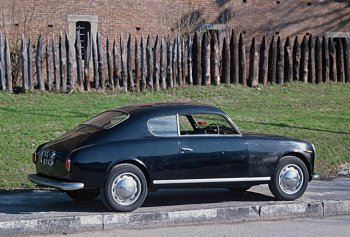 |
|
Further developments to the Aurelia B20 resulted in
a third series entering production by 1952, often
referred to as the ‘GT 2500’. |
|
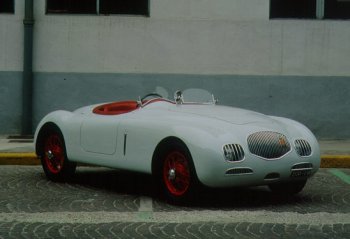 |
|
At
the end of the war, the intent of the factory was to
further develop the Aprilia theme, perhaps with a
new type of engine design. Above: 1946 Aprilia Sport (Pagani Barchetta Corsa). |
|
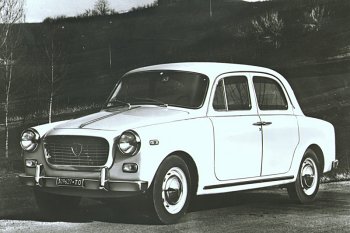 |
|
By
the time production of the Appia ceased in April 1963, well over 100,000 units
(including coachbuilt examples) had been produced, making it
the first Lancia to hit this sales mark and easily their
best-selling model to date, providing a vital source of
revenue at a difficult time for the firm. |
|
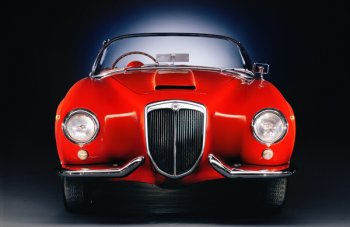
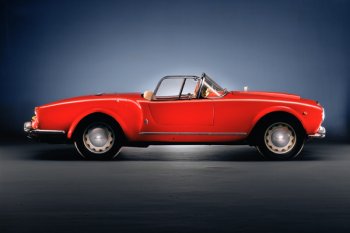
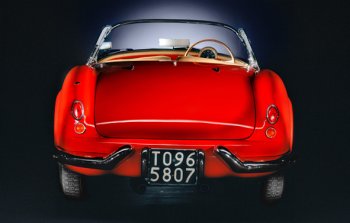 |
|
For the motorist looking for the ultimate in refined
elegance, sportiness and glamour in the 1950s, it
was difficult to go past the Aurelia B24 Spider,
first seen as a prototype in 1954 but officially
introduced during the 1955 Brussels Motor Show. |
|
|
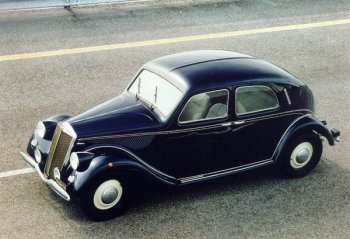 |
|
Having recently
launched the revolutionary Aprilia (above), Lancia entered a new era
in 1938, with the arrival in Turin of the legendary Vittorio
Jano, responsible for the highly-regarded and tremendously
successful Alfa Romeo P2, 1750, 2300, 2900 and P3. |
|
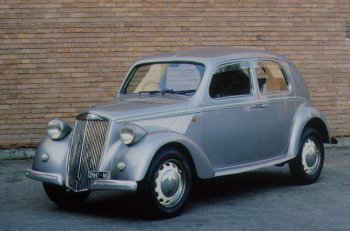 |
|
Jano’s first project on
his arrival at Via Monginevro was the Augusta’s
replacement, the Ardea, introduced as a new upmarket
utility model just prior to the outbreak of war in
1939. |
|
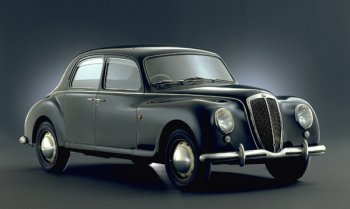
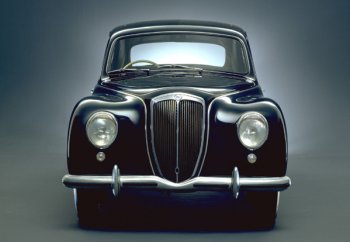
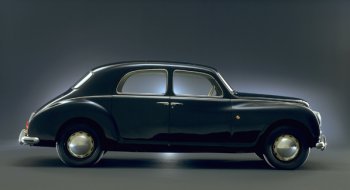 |
|
Launched at the Turin Motorshow on March 4, 1950, the
Aurelia was new from the wheels up, with its outstanding
technical highlight undoubtedly the world’s first production
V6, a feature which has guaranteed this model a hallowed
place in the annals of motoring. |
|
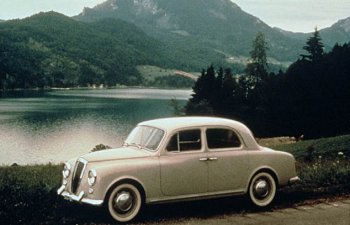 |
|
The Ardea would
be replaced as Lancia’s entry-level model by the 1953 Appia
(above),
once again overseen by Jano. Stylistically, it was another
pillarless four-door saloon which echoed the company’s
flagship model, in this case the recently-launched
Aurelia. |
|
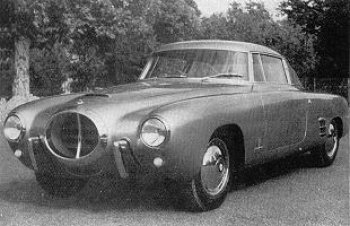
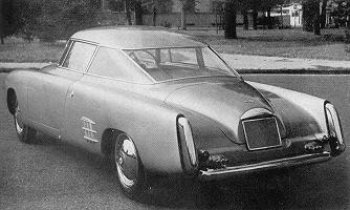 |
|
Boneschi, Vignale, Allemano, Stabilimenti Farina and Ghia,
used a special extended chassis series of the Aurelia, created by the factory, as a basis for their work, with perhaps
the most striking vehicle to emerge from these efforts a
futuristic concept car by Pinin Farina, the 1953 PF2000
(above).
|
|
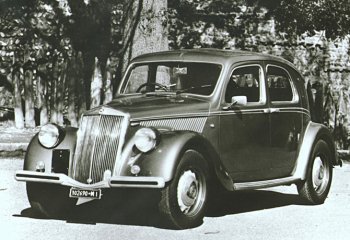 |
|
By
1955, the situation had deteriorated to the point that
Gianni Lancia and his mother were forced to sell the
family’s majority holding in the company to industrial
conglomerate Italcementi, headed by millionaire Carlo
Pesenti.
|
|
|
The berlina
received another boost in 1952 when the B22 was
released. Notwithstanding minor changes such as the
instruments and indicators, this was essentially a B21 with
a modified camshaft and a twin-choke Weber carburettor,
which helped boost power to 90 bhp. This variant continued
until 1954, when the arrival of the B12 heralded significant
changes to the Aurelia.
The most
important revision arising from this ‘second series’ was the
adoption of a de Dion suspension layout on leaf springs at
the rear, in place of the previous fully-independent setup,
which helped keep camber change in check under cornering
load and made wet-weather handling in particular more
predictable. Further modifications included the replacement
of the white-metal bearings with Vandervell items, a new
cartridge oil filter, and a new block casting. With a 2266cc
engine and 87 bhp, the B12 also incorporated numerous other
small detail changes to the design, such as the headlights,
spotlights, and wind deflectors on the windows.
Additionally,
Lancia had released a chassis with an extended wheelbase
alongside the debut of the standard car in 1950,
specifically designed for the use of the various carrozzerie. This was designated the B50, or B51 with different gear
ratios and tyres; later becoming the B52 and B53
respectively with the adoption of the 2-litre engine. A
small number of chassis with de Dion rear suspension were
also produced (B55 and B56), as well as a single B60.
Various carrozzerie, including Pinin Farina, Bertone, Viotti,
Boneschi, Vignale, Allemano, Stabilimenti Farina and Ghia,
used these chassis as a basis for their work, with perhaps
the most striking vehicle to emerge from all these efforts
being a
futuristic concept car by Pinin Farina, the 1953 PF2000.
Nonetheless, as
beautiful and striking as some of these coachbuilt cars may
have been, they were arguably overshadowed by Lancia’s own
efforts with their coupe derivative of the Aurelia, the
‘Gran Turismo’, more popularly known as the B20 GT. Once
described as, “a grand tourer which would have made the late
Vincenzo Lancia smile”, the B20 GT remains one of the most
famous Lancias ever, as well as one of the all-time great
automobiles. Built on a wheelbase some 200mm shorter than
that of the saloon, the B20 defined the modern template for
the Gran Turismo, or GT.
Although the first use of
the term was on the Alfa Romeo 6C 1750 Gran Turismo, it was
the Aurelia which popularised it and helped make ‘Gran
Turismo’ a concept in its own right. Robert Coucher
observes that, “as a Gran Turismo, the Aurelia is
superb. It’s light and minimal in construction but not
fragile like Alfa Romeos of the same era: the result of
functional weight-paring, not cost-cutting with
insubstantial components. Beneath its skin, the mechanicals
are rugged and well conceived, allowing rapid progress on
challenging roads.” At substantially more than the price of
a Jaguar D-Type in the UK, it was far from cheap, but for
those who could afford it, it offered a sublime blend of
quality, styling, performance, and dynamic integrity. It is
no surprise to find that it was extremely popular with many
racing drivers of the day, including Jean Behra, Mike
Hawthorn and Juan-Manuel Fangio.
Although the
handsome full-width bodywork of the B20 is sometimes
attributed to Pinin Farina, who tidied up the design before
its debut, it is commonly felt to largely be the work of
Ghia’s Mario Felice Boano, who amongst other projects is
noted for his work on the Alfa Romeo Giulietta Sprint. It
was only limited production capacity which prevented Ghia
from building the cars as well; the first 98 examples
produced are ascribed to Carrozzeria Viotti, while
increasing demand thereafter resulted in a shift to Pinin
Farina’s works (Lancia supplied a rolling platform to the
coachbuilder, to which hand-beaten panels were welded).
Mechanically, it was broadly as per the B21, with a slightly
tuned engine producing 75 bhp. Soon afterwards, after 500
S1 cars had been produced, production began of the second
series coupe, which used an 80 bhp version of the same
engine (the improvement obtained through repositioned valves
and a higher compression ratio). Additionally, the brakes
were improved, the ride height reduced, and a few detail
styling changes made to things such as the instrumentation
and chrome trim.
Further
developments to the B20 resulted in a third series entering
production by 1952, which was often referred to as the ‘GT
2500’. Along with some mild alterations to the styling
(especially in the profile of the tail), the V6’s capacity
was expanded to 2451cc, now developing 118 bhp. This
increase in power began to show up some weaknesses in the
suspension design, so the fourth series introduced a de Dion
layout at the rear to replace the previously independent
system in 1954, along with the possibility to buy a
left-hand drive version for the first time. Subsequent B20
models
became more biased towards luxury with somewhat superfluous
additions: the fifth series in 1956 (which added a direct
drive top gear) was heavier and had a softer cam profile for
increased torque, and with power reduced to only 110 bhp, while
the sixth and final series (1957 on) added even more weight
(a total increase of over 1000lb over the S1), not
completely offset by a minor increase in power to 112 bhp.
For the motorist
looking for the ultimate in refined elegance, sportiness and
glamour, however, it was difficult to go past the Aurelia
B24 Spider, first seen as a prototype in 1954 but officially
introduced during the 1955 Brussels Motor Show. The B24’s
bodywork was both designed and built by Pinin Farina, and it
is widely considered to be one of the coachbuilder’s most
successful designs; elements deriving from it would later
pop up in designs such as the Alfa Romeo Giulietta Spider
and Ferrari 250 GT California. Based on a fourth series B20
chassis shortened by a further 210mm, the Spider was fitted
with the latest mechanical specification from the coupe,
which meant the 2.5-litre engine and de Dion rear end, and
floor-mounted gearlevers on certain left-hand drive cars.
Only 240
examples of the Spider were produced until 1956, when it
gave way to the GT 2500 Convertible (aka
‘America’). Featuring a completely redesigned body, the
Convertible had no panels common to the Spider; the latter’s
wrap-around windscreen was ditched in favour of a flatter
windscreen with small quarterlight panels, along with deeper
doors (incorporating door handles) and one-piece straight
bumpers. The aim was to make the car more comfortable and
user-friendly, and in that aim Lancia was successful; but it
is also generally agreed that a deal of the Spider’s purity
and delicacy was sacrificed in the process.
Like the B20,
production of the Aurelia Convertible ran until 1958,
whereas production of the berlina wound up a couple of years
prior. For all its charms, significance and timeless design,
the Aurelia failed to sell in sufficient numbers to be
viable, with just over 18,000 examples of all models leaving
the factory gates over eight years (broken down into 12,786
saloons, 3871 coupes, 761 Spiders/Convertibles and 778 bare
chassis). By 1955, the situation had deteriorated to the
point that Gianni Lancia and his mother were forced to sell
the family’s majority holding in the company to industrial
conglomerate Italcementi, headed by millionaire Carlo
Pesenti.
The reasons for
the financial crisis are complex and disputed, but it is
likely that a number stem from the particular technical and
organisational culture which characterised the company from
the off. Although the Aurelia’s lack of viability placed the
company close to the financial precipice, and the huge
expense of the competition programme was the trigger for the
family’s loss of control, Giuseppe Berta is careful not to
underestimate the significance of the company’s lack of
responsiveness to developments outside the technical
arena: “Lancia’s corporate system was, in the early 1950s...a
mixture of contradictions. It produced models like the
Aurelia which overwhelmed the market, whilst its
technological and organisational modernisation was at a
standstill. It continued to pursue an ideal aspiration for
technical excellence...when in practice it had abdicated
from all entrepreneurial and managerial-type behaviour.
“(Within Lancia
during this period,) the technical control and disciplinary
authority of the company were at an all-time low, whereas
the discretionary power of the workers was extremely
high. In fact, workers, technicians and management all
shared a single mentality...the outstanding importance
attributed to the technical quality of the product and the
attention paid to some executive phases were factors that
could quite easily stand alone from an exact understanding
of the lacunae in terms of efficiency and
costing.” According to Wim Oude Weernink, under Gianni’s
leadership there had been too heavy a concentration on the
technical aspects of the Aurelia project, as well as too
much effort and expenditure on different styles and
technical variations, at the cost of sufficient investment
in plant equipment which had been ageing since the end of
the 1940s. Reinvestment in the best machine tools available,
along with the building of the Lancia skyscraper on the Via
Vincenzo Lancia, was simply not being sufficiently repaid by
the weekly output of under 180 cars. In short, he says,
“Lancia was dominated by a technical and engineering
culture, exclusively concentrated on the project, and it was
this that finally inveigled the company to embark on the
extremely costly adventure of racing.”
Unfortunately
for Gianni, the racing programme would have a negligible
impact in improving the company’s sales. If nothing else,
however, it would bring fame to the company, establishing
the Lancia name in motor racing in some style, and provide a
suitable arena where the Aurelia’s outstanding handling and
performance characteristics could be put on show. The
sensational debut of a B20 GT on the 1951 Mille Miglia,
where it finished second overall, marked the beginning of
the factory’s steadily increasing commitment to motor racing
– a commitment which would ultimately culminate in Lancia’s
first and only Formula 1 car, and the adoption of the famed
‘running elephant’ logo to designate Lancia competition
cars. Between 1951 and 1955, the Aurelia and the specialist
racing cars which followed it would achieve a great number
of successes, going head-to-head against the likes of Alfa
Romeo and Ferrari.
by Shant Fabricatorian
|
|
|
|
![]()
![]()